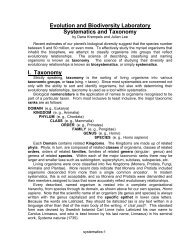LABORATORY 4 Creating an Effective Scientific Presentation
LABORATORY 4 Creating an Effective Scientific Presentation
LABORATORY 4 Creating an Effective Scientific Presentation
You also want an ePaper? Increase the reach of your titles
YUMPU automatically turns print PDFs into web optimized ePapers that Google loves.
Rehearse with someone other th<strong>an</strong> your teammates, <strong>an</strong>d preferably someone whohas not seen your presentation. Ask for honest feedback about colors, content, <strong>an</strong>doverall efficacy of the presentation.Don't read from your slides. Your slides are there for the audience, not you. Youshould already know what's there, <strong>an</strong>d be able to speak about your slide topic withoutprompting from the slide itself.Don't speak to your slides. One of the most common mistakes presenters make isto face the screen as they deliver a presentation. Not only c<strong>an</strong> your audience not seeyour face, but they usually will not be able to hear you. Few things make as bad <strong>an</strong>impression.Don't apologize for <strong>an</strong>ything in your presentation. If a slide is hard to read orunderst<strong>an</strong>d, then don't use it.If you are not running the presentation from your own computer, download it to theprojection computer's desktop. It will run faster th<strong>an</strong> if you try to run it from a CD orexternal drive.II. <strong>Presentation</strong>: The ContentAt scientific meetings, research is presented in different formats, including postersessions <strong>an</strong>d presented talks. Remember that you are presenting the results of ascientific investigation, not a corporate speech, nor <strong>an</strong> entertainment. Follow the formatgenerally used in scientific publications, with a few import<strong>an</strong>t modifications.A. TitleWhen you eventually publish your work, it is the title of your paper that will be readby the most readers, <strong>an</strong>d it is the title that often will determine whether the rest of yourpaper will be read at all. It should describe specifically the content of your paper.Under the title, list the names of all authors, as well as the institutional affiliation of each.(In case you don't know, yours is the University of Miami Biology Department)B. AbstractAn abstract is a brief paragraph, usually found under the title of a published paper, inwhich the investigators give a skeletal outline of the purpose, results, <strong>an</strong>d conclusions oftheir research. The purpose of <strong>an</strong> abstract is to allow a reader to determine, with a veryquick sc<strong>an</strong>, what a published paper is about, how it was done, <strong>an</strong>d what wasdiscovered. Although the abstract appears first, it is written last.Power Point presentations in scientific meetings rarely include <strong>an</strong> abstract, thoughthe investigators may sometimes provide one as a h<strong>an</strong>dout. In our class, because wewish to save precious resources, we ask that you not provide <strong>an</strong>y h<strong>an</strong>douts.C. IntroductionThis section should give the specific background of your experiment. Becauseeveryone in the lab has performed experiments investigating the function of yeastcatalase, don't be surprised if m<strong>an</strong>y of your colleagues say some of the same things youdo. This isn’t a problem. Present the best information on your specific hypothesis <strong>an</strong>dresearch to prepare your colleagues for what you intend to teach them. Include suchthings as1. What is <strong>an</strong> enzyme, <strong>an</strong>d what is catalase?2. What is a substrate, <strong>an</strong>d what is hydrogen peroxide?3. What is the observation that inspired this research?3-3
















